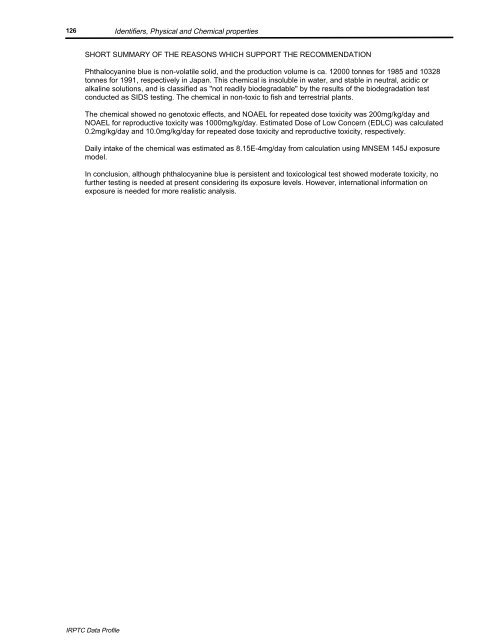Copper phthalocyanine (SIDS)
Copper phthalocyanine (SIDS)
Copper phthalocyanine (SIDS)
Create successful ePaper yourself
Turn your PDF publications into a flip-book with our unique Google optimized e-Paper software.
126<br />
Identifiers, Physical and Chemical properties<br />
SHORT SUMMARY OF THE REASONS WHICH SUPPORT THE RECOMMENDATION<br />
Phthalocyanine blue is non-volatile solid, and the production volume is ca. 12000 tonnes for 1985 and 10328<br />
tonnes for 1991, respectively in Japan. This chemical is insoluble in water, and stable in neutral, acidic or<br />
alkaline solutions, and is classified as "not readily biodegradable" by the results of the biodegradation test<br />
conducted as <strong>SIDS</strong> testing. The chemical in non-toxic to fish and terrestrial plants.<br />
The chemical showed no genotoxic effects, and NOAEL for repeated dose toxicity was 200mg/kg/day and<br />
NOAEL for reproductive toxicity was 1000mg/kg/day. Estimated Dose of Low Concern (EDLC) was calculated<br />
0.2mg/kg/day and 10.0mg/kg/day for repeated dose toxicity and reproductive toxicity, respectively.<br />
Daily intake of the chemical was estimated as 8.15E-4mg/day from calculation using MNSEM 145J exposure<br />
model.<br />
In conclusion, although <strong>phthalocyanine</strong> blue is persistent and toxicological test showed moderate toxicity, no<br />
further testing is needed at present considering its exposure levels. However, international information on<br />
exposure is needed for more realistic analysis.<br />
IRPTC Data Profile
















